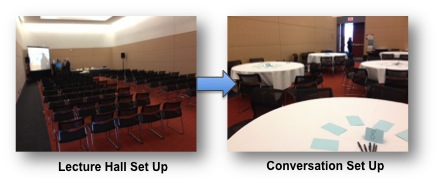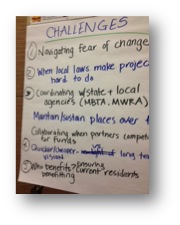Most of us know well the traditional conference format of a speaker or panel at the front of the room, rows of chairs, speakers offering prepared remarks with Powerpoint slides, followed by some Q&A with the audience. Interest is growing in ways to organize conferences that enable more interaction, connections, and learning among the participants. As with any innovation, some people are enthused to jump on board and try new techniques, such as Open Space, but they need to find ways to navigate and work with those who are comfortable and satisfied with the “way it is done now.” The good news is that you can integrate these interactive formats within a traditional conference format.
Here is one model we used to design in interaction within a 1.5 hour concurrent breakout session format at the Massachusetts Smart Growth conference in Boston. We helped design and facilitate a morning and afternoon breakout session on the topic of placemaking, hosted by the Great Neighborhoods Network. The design included speakers to share case studies and tips, combined with interactive conversations among the audience taking the themes deeper. The session looked similar to a typical breakout session in the conference materials; however, the actual experience was much more interactive.
The conference breakout room was set up with round tables of 8-10 instead of rows to enable more interaction and conversation:
 The agenda was as follows:
The agenda was as follows:
- Welcome, overview of the topic (10 minutes)
- “Firestarter stories” (30 minutes total) – Three speakers each shared a story of how they had implemented this approach in their community, taking 5-10 minutes each, with slides of visuals, (e.g., how they did it, what it’s led to/enabled, challenges or key learning along the way)
- Stories from the room (5 minutes) – The facilitator asked the audience to share stories they knew of that others might like to learn about. These were gathered on a flip chart with names for people to follow up.
- Conversations about key challenges in small groups (25 minutes) – We worked with the speakers ahead of time to develop a list of the four to six most common challenges people face in doing this work. The round tables each had a number and we assigned a topic to each table and had the speakers split up amongst the tables. The audience was invited to join a conversation of interest and to move around during the event if that did not turn out to be a fit.

- Harvest key learnings (15 minutes) – The facilitator asked people to briefly share highlights and new ideas/resources, so people could get a sense of learning from the other conversations.
The room was buzzing with conversation after each session and people stayed 15-20 minutes after it was over, engrossed in conversations.
Some of the additional benefits of this design over a typical session with speakers taking most of the time are:
- The audience can access the experiences and expertise of the 40-50 people in the room as well as the handful of speakers.
- Those interested in a similar challenge or topic can find each other when people self-select the small group conversation they would like to join.
- Part of a reason to attend a conference is to make new connections and meet people. Conversations on a topic of mutual interest are a more fertile context to build new relationships that can lead to follow up and exchange.
- The understanding of the dynamics of a challenge can be richer when you hear the experiences and perspectives of 5-15 people in a small group and a conversation gets started where ideas can be exchanged and build on each other.
- Audience members who are most interested in a speaker’s story get a chance to interact in a small group to hear more about it.
- We learn and absorb information not only by listening, but also by talking about our own experiences and questions. Small group conversations open the door to this reflection and integration of the information.
